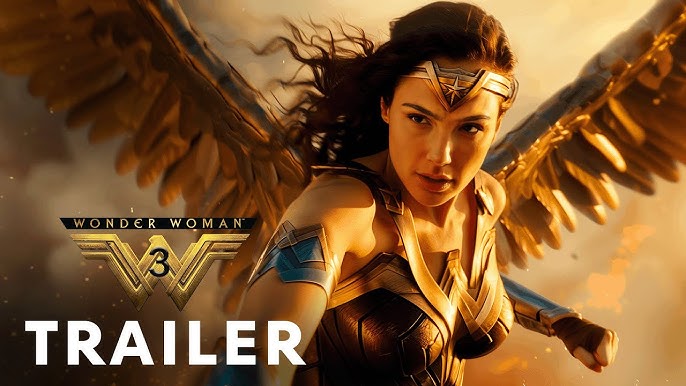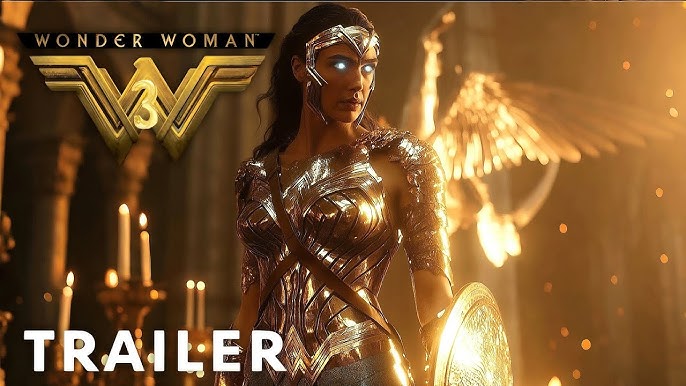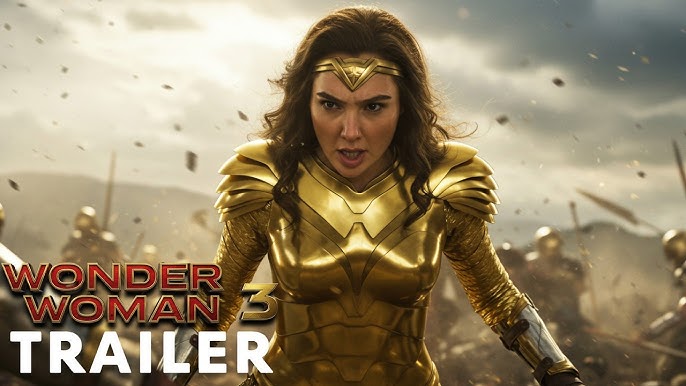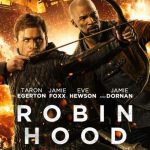Wonder Woman 3 (2025)

Wonder Woman 3 (2025)
Starring: Gal Gadot | Jessica Lyonne | Pedro Pascal | Jason Momoa | Chris Pine
Wonder Woman 3 returns to the cinematic landscape with a narrative that is as epic in scope as it is intimate in emotional depth. Diana Prince, portrayed once again by Gal Gadot, finds herself at the crossroads of gods and mortals, power and responsibility, courage and doubt. The film delves deeper into Diana’s psyche, exploring the burdens of divinity alongside the vulnerabilities of humanity, all while delivering breathtaking action, mythic stakes, and profound moral questions. It is a story that balances spectacular spectacle with the intimate drama of a hero confronting not only external threats but also the internal costs of her role as protector of both Earth and Olympus.
The narrative opens with Diana attempting to maintain peace between the realms of gods and humans. In the aftermath of previous battles, tensions linger, leaving the world on edge. Diana’s leadership is tested not only by her own doubts but also by the machinations of beings who seek to exploit the fragile balance between mortals and immortals. Here, the film immediately establishes a central thematic tension: the weight of divine power is inseparable from personal sacrifice. Diana’s internal struggle is palpable; she wields immense strength yet questions whether her interventions help or harm the world she seeks to protect.
Jessica Lyonne joins the cast as a radical force, a mortal imbued with a fervent vision that challenges the status quo. Her character is not merely an antagonist but a spark of passion and rebellion that pushes Diana to reevaluate her understanding of justice and duty. Lyonne’s performance is a dynamic counterpoint to Gadot’s measured heroism; where Diana’s power is tempered by wisdom and caution, Lyonne’s impulsiveness and intensity inject unpredictability into the narrative, creating conflict that is as ideological as it is physical. The friction between these two forces drives much of the film’s tension, emphasizing that the greatest battles often occur not on the battlefield but within the heart.
Pedro Pascal’s portrayal of a divine rebel introduces an additional layer of complexity to the story. Charismatic, dangerous, and morally ambiguous, Pascal’s character represents the seductive pull of power unbound by morality. His interactions with Diana test her convictions, forcing her to navigate alliances fraught with risk and uncertainty. The stakes are further heightened by the presence of Jason Momoa, whose elemental ferocity brings a primal, unstoppable energy to the narrative. Momoa’s character is both a formidable ally and a force of nature in his own right, representing the unpredictable and often destructive power of raw emotion and instinct.
Chris Pine lends a haunting presence to the film, his voice echoing as a spectral guide and a reminder of the sacrifices inherent in heroism. Through Pine’s ethereal contributions, the narrative continually underscores the personal costs of leadership and the ways in which past choices resonate into the present. This layered storytelling allows the film to explore profound themes—duty, loss, legacy—without sacrificing the pulse-pounding intensity that audiences expect from a Wonder Woman adventure.
Visually, Wonder Woman 3 is a triumph. From storm-charged battles that engulf entire landscapes to intimate duels that crackle with tension, the film employs state-of-the-art cinematography and visual effects to create a world that is simultaneously mythic and tangible. Symbolism is woven throughout every scene: lightning arcs as a mirror to Diana’s internal struggle, cascading debris reflects the chaos of divine conflict, and subtle visual cues—glimmers of gold, shadows of the past—underscore the stakes of each confrontation. The choreography of combat is both elegant and brutal; hand-to-hand duels, strategic use of Diana’s weapons, and elemental clashes are staged with precision, creating sequences that are as visually striking as they are narratively meaningful.
The narrative is structured around multiple converging arcs. Diana’s struggle to maintain balance is mirrored by the tensions among gods, rebels, and mortals, each with their own ambitions, fears, and moral codes. Lyonne’s radicalism challenges not only Diana but also the established order, forcing a reevaluation of what justice means in a world where power can corrupt or protect. Pascal’s rebellion adds layers of intrigue and uncertainty, as alliances shift and trust becomes a scarce commodity. Momoa’s elemental force introduces unpredictability, while Pine’s ghostly voice provides reflection and emotional resonance, reminding Diana—and the audience—of the consequences of every action.
The film excels at balancing epic spectacle with intimate character moments. In quieter sequences, Diana grapples with doubt, grief, and the responsibilities of leadership. Gadot delivers a performance that captures both strength and vulnerability, portraying a hero who is capable of extraordinary feats yet profoundly human in her self-doubt and compassion. These moments are interspersed with high-stakes action, creating a rhythm that keeps audiences engaged while grounding the story in emotional truth.
Wonder Woman’s allies and adversaries alike are given depth and complexity. Secondary characters are not mere supporting players but active agents whose decisions influence the narrative trajectory. Their interactions with Diana highlight her leadership style, moral reasoning, and capacity for empathy. Each confrontation, whether ideological or physical, is imbued with stakes that resonate on both personal and cosmic levels, reinforcing the film’s central theme: true heroism requires courage, discernment, and the willingness to bear the weight of impossible choices.
The score and sound design are integral to the film’s emotional and narrative impact. Orchestral themes swell during battle, capturing both the grandeur and danger of divine conflict. Subtle motifs accompany moments of introspection, underscoring the gravity of Diana’s internal struggles. Sound effects—from the clash of weapons to the roar of storms—are crafted to immerse the audience fully, enhancing the intensity and realism of each sequence. Music and sound become a narrative tool in themselves, reflecting the film’s oscillation between spectacle and introspection.
Philosophically, Wonder Woman 3 explores the tension between destiny and choice. Diana is confronted with forces that test her understanding of morality, power, and responsibility. The film repeatedly asks whether the ends justify the means, whether strength alone is sufficient to maintain peace, and how one balances personal desire with the greater good. These questions are never abstract; they are embedded in the characters’ interactions, decisions, and conflicts, making the narrative resonate on a level that is both intellectual and emotional.
Action sequences are meticulously crafted to reflect character and theme. The storm-charged duels between gods and mortals are not only displays of spectacle but also metaphors for internal struggle. Lightning, wind, and elemental forces are choreographed to mirror Diana’s fluctuating confidence and the moral turbulence of the narrative. Every blow, every deflection, and every maneuver carries symbolic weight, reinforcing the interplay between external conflict and internal growth.
The film’s cinematography emphasizes scope and scale, often juxtaposing intimate close-ups with wide panoramic shots of battlefields, storm-swept landscapes, and divine realms. This visual technique allows audiences to feel the personal stakes of the characters while appreciating the grandeur of the mythic world they inhabit. Lighting and color are used deliberately to convey mood: muted tones for moments of doubt, vibrant hues for heroism and triumph, and shadowed contrasts for moral ambiguity.
Ultimately, Wonder Woman 3 is a film about the humanization of a deity and the divinization of a hero. Diana Prince embodies a unique intersection of power and vulnerability, courage and compassion, morality and pragmatism. Gadot’s performance captures the duality of this character with nuance and intensity, ensuring that audiences are invested not only in the external battles she faces but also in her internal journey.
The climax delivers a thunderous spectacle that resolves the narrative arcs while emphasizing the emotional core of the story. Symbolic standoffs, elemental confrontations, and strategic battles converge into a crescendo that is both visually and narratively satisfying. Diana’s victories are hard-won, grounded in her wisdom, moral integrity, and ability to inspire loyalty and courage in those around her. The resolution emphasizes that true heroism lies not solely in strength or power but in the capacity to lead with heart, discernment, and resilience.
In conclusion, Wonder Woman 3 is a masterful blend of mythology, action, and character-driven storytelling. It balances epic spectacle with intimate drama, offering audiences a story that is simultaneously grand in scope and human in heart. The combination of Gal Gadot’s compelling performance, the dynamic presence of Lyonne, Pascal, and Momoa, and the thoughtful integration of visual, auditory, and narrative elements ensures that the film is both an emotional and cinematic triumph.
Wonder Woman 3 is not merely a continuation of a franchise; it is a meditation on power, responsibility, and sacrifice. It challenges audiences to consider the costs of heroism, the importance of moral clarity, and the necessity of courage in the face of insurmountable odds. With its blend of thunderous spectacle, profound character exploration, and morally resonant storytelling, the film stands as one of the most ambitious and compelling entries in the DC cinematic universe.
Rating: 5 out of 5
Related Movies






